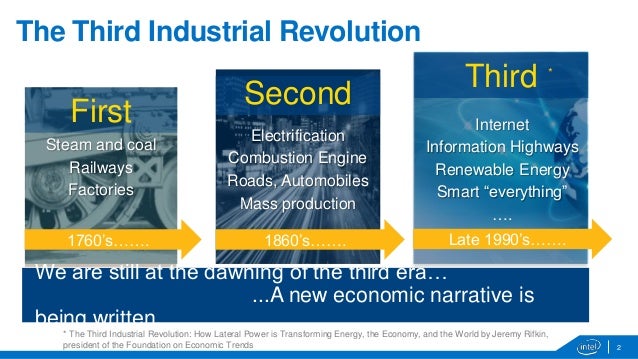The Third Industrial Revolution

The first industrial revolution began in Britain in the late 18th century, with the mechanisation of the textile industry. Tasks previously done laboriously by hand in hundreds of weavers' cottages were brought together in a single cotton mill, and the factory was born.
The second industrial revolution came in the early 20th century, when Henry Ford mastered the moving assembly line and ushered in the age of mass production. The first two industrial revolutions made people richer and more urban.
Now a third revolution is under way. Manufacturing is going digital. As this week's special report argues, this could change not just business, but much else besides.
A number of remarkable technologies are converging: clever software, novel materials, more dexterous robots, new processes (notably three-dimensional printing) and a whole range of web-based services. The factory of the past was based on cranking out zillions of identical products: Ford famously said that car-buyers could have any colour they liked, as long as it was black.
But the cost of producing much smaller batches of a wider variety, with each product tailored precisely to each customer's whims, is falling. The factory of the future will focus on mass customisation—and may look more like those weavers' cottages than Ford's assembly line.
The old way of making things involved taking lots of parts and screwing or welding them together. Now a product can be designed on a computer and “printed” on a 3D printer, which creates a solid object by building up successive layers of material. The digital design can be tweaked with a few mouse clicks.
The 3D printer can run unattended, and can make many things, which are too complex for a traditional factory to handle. In time, these amazing machines may be able to make almost anything, anywhere—from your garage to an African village.
The applications of 3D printing are especially mind-boggling. Already, hearing aids and high-tech parts of military jets are being printed in customised shapes. The geography of supply chains will change. An engineer working in the middle of a desert who finds he lacks a certain tool no longer has to have it delivered from the nearest city. He can simply download the design and print it. The days when projects ground to a halt for want of a piece of kit, or when customers complained that they could no longer find spare parts for things they had bought, will one day seem quaint.
Other changes are nearly as momentous. New materials are lighter, stronger and more durable than the old ones. Carbon fibre is replacing steel and aluminum in products ranging from aeroplanes to mountain bikes. New techniques let engineers shape objects at a tiny scale.
Nanotechnology is giving products enhanced features, such as bandages that help heal cuts, engines that run more efficiently and crockery that cleans more easily. Genetically engineered viruses are being developed to make items such as batteries. And with the Internet allowing ever more designers to collaborate on new products, the barriers to entry are falling. Ford needed heaps of capital to build his colossal River Rouge factory; his modern equivalent can start with little besides a laptop and a hunger to invent.
Like all revolutions, this one will be disruptive. Digital technology has already rocked the media and retailing industries, just as cotton mills crushed hand looms and the Model T put farriers out of work. Many people will look at the factories of the future and shudder. They will not be full of grimy machines manned by men in oily overalls. Many will be squeaky clean—and almost deserted. Some carmakers already produce twice as many vehicles per employee as they did only a decade or so ago.
Most jobs will not be on the factory floor but in the offices nearby, which will be full of designers, engineers, IT specialists, logistics experts, marketing staff and other professionals. The manufacturing jobs of the future will require more skills. Many dull, repetitive tasks will become obsolete: you no longer need riveters when a product has no rivets.
The revolution will affect not only how things are made, but where. Factories used to move to low-wage countries to curb labour costs. But labour costs are growing less and less important: a $499 first-generation iPad included only about $33 of manufacturing labour, of which the final assembly in China accounted for just $8.
Offshore production is increasingly moving back to rich countries not because Chinese wages are rising, but because companies now want to be closer to their customers so that they can respond more quickly to changes in demand. And some products are so sophisticated that it helps to have the people who design them and the people who make them in the same place.
New paradigms are becoming dominant. Adaptability and nimbleness are being sought over predictability and scale. Value chains are being replaced by fluid multi-tiered ecosystems. Ownership is being trumped by access. Talent is becoming global and freelancing is growing over full-time employment. Open innovation, crowdsourcing and the maker movement are gaining ground over big labs. Networks are overcoming hierarchies.
The speed of Revolution 3.0 is brutal due to its digital and exponential nature. Its magnitude will also dwarf previous revolutions. For example, IDC predicts that we will generate 44ZB of data by 2020 versus 1.8ZB in 2011.
But qualitative quantum leaps make it unique. While other revolutions replaced muscles, smart machines are now replacing humans in cognitive functions. We can read, edit and print DNA and create new life forms. We will have to move from biosphere exploitation to regeneration. We are on our way to become a multi-planetary species.
Revolutions 1.0 and 2.0 brought massive conflict and adaptation costs in the form of conflict, inequality and pollution. During Revolution 2.0 we paid the price for the abuses of Revolution 1.0 in the form of communism and racial tensions. In Revolution 3.0 we will pay the price of Revolution 2.0 in the form of debt and environmental stress. Why not hack the future and make it better?['
We can reinvent education to make it relevant for the future and address the growing skills mismatch challenge. We need to get ready for a world with fewer jobs and abundant opportunities. We can stimulate the development of technologies to cover basic necessities at a small fraction of the cost. We can accelerate the growth of renewables to make energy abundant and cheap, boost global growth and reverse greenhouse gas emission trends.
Ignoring or resisting change and protecting the structures of Revolution 2.0 over the emergence of Revolution 3.0 will involve a hefty price. History shows that those who proactively embrace and lead technology revolutions reap their benefits. Let's surf the technology tsunami coming our way and make the future better.
Economist: http://econ.st/1rLuBRy
HuffPo: http://huff.to/1HpWKB2


























